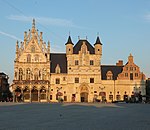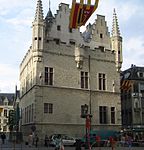Mechelen Toy Museum
The Mechelen Toy Museum (Dutch: Speelgoedmuseum Mechelen) is a Toy Museum\ situated in the Nekkerspoel hamlet in Mechelen, Belgium, is a museum containing a unique collection of past and contemporary toys on a total surface of 7,000 m2. The museum was founded in April 1982, and since 1998 it is a recognized museum. The permanent collection is subdivided in the following categories: Circus and kermesse Construction toys Creative and educational toys Stuffed toys Mechanical and iron toys Optical and sound-making toys Puppets Puzzles and board games Soldiers Toys around the world Traditional child games and Pieter Bruegel Trains Transport in miniatureApart from that there are also changing exhibitions. The museum also has an educational service with school programmes.
Excerpt from the Wikipedia article Mechelen Toy Museum (License: CC BY-SA 3.0, Authors).Mechelen Toy Museum
Nekkerspoelstraat,
Geographical coordinates (GPS) Address Nearby Places Show on map
Geographical coordinates (GPS)
| Latitude | Longitude |
|---|---|
| N 51.030277777778 ° | E 4.4908333333333 ° |
Address
Nekkerspoelstraat 7
2800 , Nekkerspoel (Mechelen)
Antwerp, Belgium
Open on Google Maps









